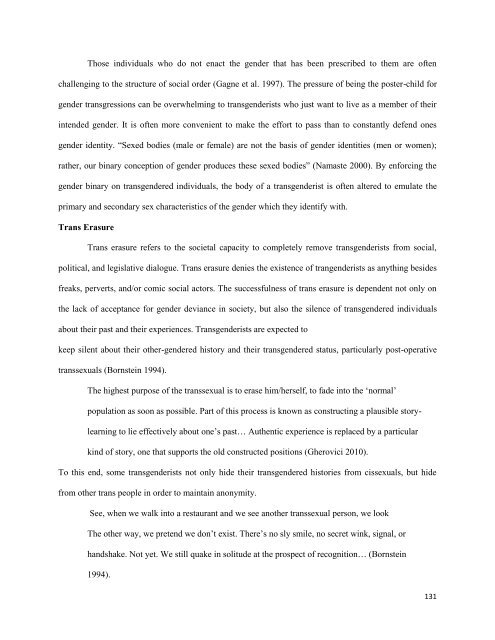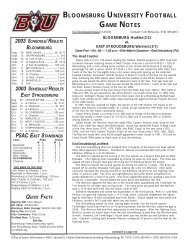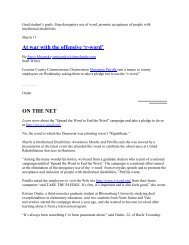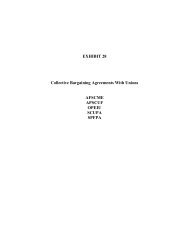Human Rights at Home and Abroad: Past, Present, and Future
Human Rights at Home and Abroad: Past, Present, and Future
Human Rights at Home and Abroad: Past, Present, and Future
Create successful ePaper yourself
Turn your PDF publications into a flip-book with our unique Google optimized e-Paper software.
Those individuals who do not enact the gender th<strong>at</strong> has been prescribed to them are often<br />
challenging to the structure of social order (Gagne et al. 1997). The pressure of being the poster-child for<br />
gender transgressions can be overwhelming to transgenderists who just want to live as a member of their<br />
intended gender. It is often more convenient to make the effort to pass than to constantly defend ones<br />
gender identity. ―Sexed bodies (male or female) are not the basis of gender identities (men or women);<br />
r<strong>at</strong>her, our binary conception of gender produces these sexed bodies‖ (Namaste 2000). By enforcing the<br />
gender binary on transgendered individuals, the body of a transgenderist is often altered to emul<strong>at</strong>e the<br />
primary <strong>and</strong> secondary sex characteristics of the gender which they identify with.<br />
Trans Erasure<br />
Trans erasure refers to the societal capacity to completely remove transgenderists from social,<br />
political, <strong>and</strong> legisl<strong>at</strong>ive dialogue. Trans erasure denies the existence of trangenderists as anything besides<br />
freaks, perverts, <strong>and</strong>/or comic social actors. The successfulness of trans erasure is dependent not only on<br />
the lack of acceptance for gender deviance in society, but also the silence of transgendered individuals<br />
about their past <strong>and</strong> their experiences. Transgenderists are expected to<br />
keep silent about their other-gendered history <strong>and</strong> their transgendered st<strong>at</strong>us, particularly post-oper<strong>at</strong>ive<br />
transsexuals (Bornstein 1994).<br />
The highest purpose of the transsexual is to erase him/herself, to fade into the ‗normal‘<br />
popul<strong>at</strong>ion as soon as possible. Part of this process is known as constructing a plausible story-<br />
learning to lie effectively about one‘s past… Authentic experience is replaced by a particular<br />
kind of story, one th<strong>at</strong> supports the old constructed positions (Gherovici 2010).<br />
To this end, some transgenderists not only hide their transgendered histories from cissexuals, but hide<br />
from other trans people in order to maintain anonymity.<br />
See, when we walk into a restaurant <strong>and</strong> we see another transsexual person, we look<br />
The other way, we pretend we don‘t exist. There‘s no sly smile, no secret wink, signal, or<br />
h<strong>and</strong>shake. Not yet. We still quake in solitude <strong>at</strong> the prospect of recognition… (Bornstein<br />
1994).<br />
131
















